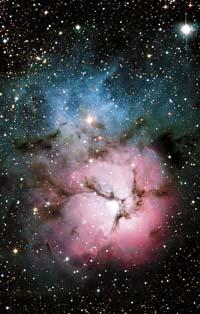Borders to know the newborn universe

The current idea of the universe is very different. In recent years the theoretical models have made great advances and we have carried out very precise cosmological experiments. With all this we have achieved a standard cosmological model. According to the standard model, the universe was born 14 billion years ago (approximately), and had very high densities and temperatures. Since then, the universe has been growing and cooling, and as it has cooled, there have been transitions of cosmological phase from a warm, high-density universe, little by little, until we reach the universe we observe today.
Let's try to see the life of the universe upside down, starting with the present universe and going back in time to the new home universe. The more backward it goes in time --increasingly young universe-, the greater the density and temperature. Imagine that we put a piece of ice in a box and heat it: first the ice will melt and then it will turn into steam; from there, if we increase the temperature, will something more steam? Our daily culinary experience tells us that water becomes steam at 100ºC and that perhaps at 200 or 300 degrees nothing happens... But at 1,000 degrees or 1,000,000 degrees?
In studying the universe, a similar situation arises. The information obtained in the temperatures we can obtain in our laboratories helps us predict how the universe was when it was younger. But for very high temperatures (a very young universe) we do not have experimental knowledge.
There is the custom of classifying the history of the universe into three epochs: the present universe, the young universe, and the newborn universe. The present universe coincides with the image we all have in the head: it is mostly empty and occasionally there are stars, quasars, galaxies and groups of galaxies. We can observe this universe directly, analyzing the light emitted by stars, galaxies, etc.
The young universe (approximately 100 million years) is more difficult to imagine. This universe has no stars, no galaxies, no objects of this type; electrons, protons and neutrons have been formed for the first time. But despite being more difficult to imagine, the physics we need to explain all these processes is largely known. According to the analogy used above, the temperature of the young universe is the same that we can achieve in our laboratories.
What's more, in the young universe two very important facts happened and today we can measure the direct consequences of what happened then. On the one hand, when the universe was 3 minutes the nucleosenesis occurred, that is, for the first time atomic nuclei were formed. The predictions made by the current theory of nucleosintesis coincide with the measures. On the other hand, when the universe was 300,000 years old, there was also recombination, that is, the capture of electrons released by atomic nuclei and the formation of atoms. The photograph of that time can be obtained directly by measuring the microwave background radiation (CMB, Cosmic Microwave Background). Therefore, what happened in the young universe is quite controlled.
To say what happened in the newborn universe is much more difficult. At that time (approximately when the universe was between 10 and 36 seconds), temperatures and densities were very high. Below this point, the physics of very large and very small scales begins to speak to each other or, in other words, to explain this time it is necessary to combine the general relativity of Einstein (large scales) with quantum physics (very small scales). And we still do not know how to formulate quantum general relativity. We have theoretical models in hand, and some of the basic characteristics are known, but in most cases they are only suspicions with good background.
Of course, from the point of view, we could say that it is a lie that we understand the time when the universe was between 10 and 36 seconds, because, do we understand the present universe? According to the standard cosmological model, the components of the universe are: 4% normal matter (atoms, light, electrons...), 22% dark matter and 74% dark energy. The only thing we know well is normal matter. We do not know very well what dark matter is, but it is quite clear that it is not "normal" matter, it is not something we can measure in our laboratories. And the dark energy is even more mysterious.
However, our knowledge of the evolution of the universe is very profound and through different experiments we can explain what happens at different scales and situations. Wonderful. And the future seems more interesting. So be attentive!
Jon Urrestilla. Doctor of Physics and researcher at the University of Sussex.






